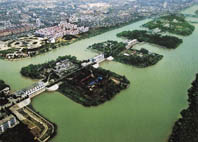Water: The Ultimate Solution
By LI SONGBAI & GAO YAN
 |
| The Jiangdu water conservancy pivot, at the source of the eastern route. |
WATER is the source of life, and without it life could not survive. Despite China's natural wealth, it has always had a serious water shortage, and as a result water has occupied a special place in the Chinese imagination since ancient times. Yu the Great, a legendary figure who lived during the 21st century B.C., became a national hero for his engineering success in subduing floods. Many impressive water conservancy projects have been built in China throughout the centuries, such as the 2,000-year-old Dujiangyan reservoir, and the Grand Canal during the Sui Dynasty. In spite of these magnificent feats, however, China continues to suffer periodic shortages, which seriously hinders its progress.
"The south has abundant water, while the north has little," said Chairman Mao Zedong in October 1952 after listening to a report about a possible strategy to tackle the shortage. "Why not borrow some from the south?" Following this remark, a heated debate began concerning the South-to-North Water Diversion Project.
After 50 years of debate, research and planning, the largest water conservancy project in Chinese history was finalized. Three routes – the western, the central and the eastern – are to be built to bring water from the upper, middle and lower reaches of the Yangtze River.
Once completed, these routes will connect the Yangtze, the Huaihe, the Yellow and the Haihe rivers into an immense network, which may finally quench the country's endemic thirst. On December 27, 2002, after repeated discussions and verifications, the impressive South-to-North Water Diversion Project began with its eastern and central routes as the initial stages.
Six years later, the project has made quick and steady progress. Its eastern route in Jiangsu is nearly complete, and is scheduled to begin delivering water north in late 2008. On hearing the news, a China Today reporter immediately rushed to the construction site for a first-hand report.
The First Stage Nearly Complete
Examining the construction map provided by the State Council, the routes resemble a necklace, with key engineering sites along the way its pearls. Although they all appear the same on the schematic, on the ground these "pearls" are quite different from each other.
On a beautiful autumn day, while construction was going full steam on the Jiangsu section, we arrived and were kindly received by the engineers in charge of the construction, and those who will be responsible for the water supply once the project is completed.
One local official explained Jiangsu's historic role in supplying water to the parched north. According to him, the construction in Jiangsu involves two parts: the original Yangtze River network that diverts water north, and new constructions. As far back as the 1950s, Jiangsu started to divert the Yangtze River to ease water shortage in northern Jiangsu. The idea for the current project is to expand and extend the existing diversion network.
The eastern route will fetch water from Yangzhou, a city on the lower reaches of the Yangtze, and then send it north via the Beijing-Hangzhou Grand Canal and the rivers parallel to it, lifting the water level 13 times along the way. This route will connect all the lakes along the way – Hongze, Luoma, Nansi and Dongping. After Dongping Lake, the route will branch into two parts. The northbound canal – 1,156 kilometers long – will cross the Yellow River to Tianjin via the tunnel through Mount Wei in Shandong. The 701-kilometer eastern bound canal will flow via the network in eastern Shandong to deliver water to Yantai and Weihai.
All eight construction sites of the project in Jiangsu are proceeding at top speed. Most of the investments, RMB 2.5 billion in total, have been made. The Sanyang-Tonghe-Baoying section was the first to be started, to be completed and to function.
The engineering focus for Jiangsu this year is on water source and the places that connect the constructions of other provinces, and to accomplish the first objective – delivering water of good quality and in satisfactory quantity. The completed Jiangsu section, with both the old and the newly added parts, will be able to send water out of the province by the end of this year.
A Clean, Pollution-free Route
If we liken the south-to-north water project to a necklace, then all of its constructions must be pearls of the highest quality. One substandard structure will ruin the whole.
The south-to-north water project involves two considerations – delivering water and pollution control. The former involves expanding and improving current facilities, with 14 pumping stations either to be built or to be enlarged. When these constructions are completed, two routes will be ready to deliver water.
Pollution control will involve control of the Huaihe River, with 26 water processing plants to be built to treat water discharged from cities, a reworked industrial structure, and a comprehensive project to cover all industries, rivers and lakes along the way.
Pollution control tops the list of priorities for the south-to-north water project, which began simultaneously with its construction.
| 